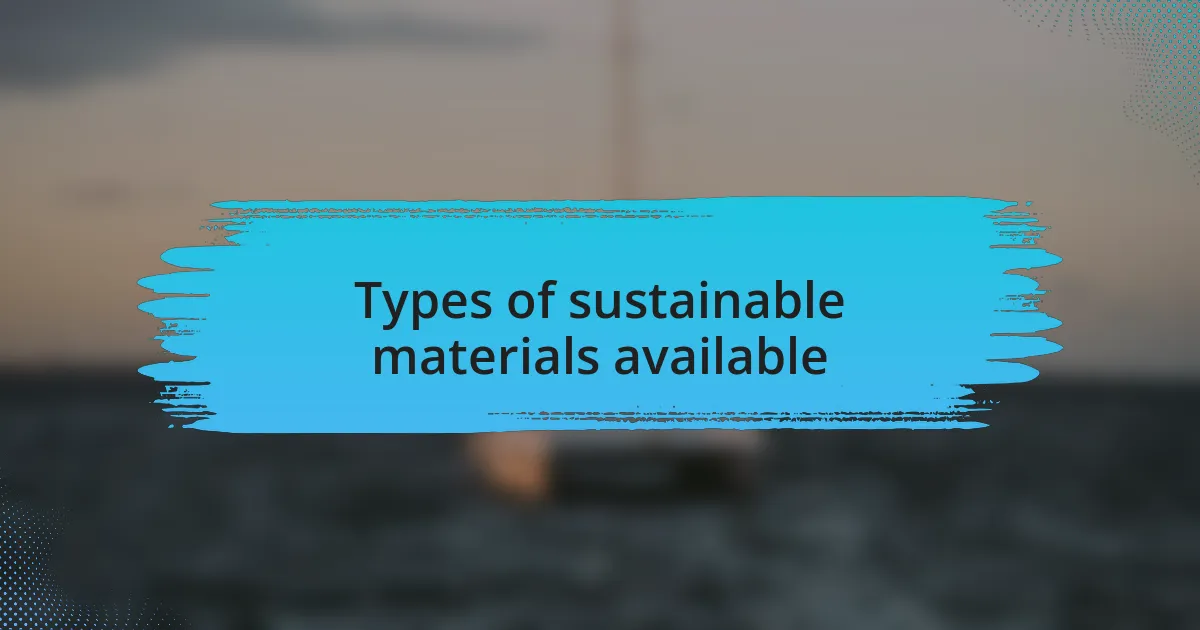Key takeaways:
- Sustainable materials minimize environmental impact and can support ecosystems while also serving as a design choice that promotes luxury.
- The exploration of innovative materials like bamboo, bio-resins, and recycled glass emphasizes a blend of aesthetics and sustainability in yacht design.
- Durability is essential in luxury design, highlighting the balance between beauty and functionality with materials that tell a story.
- Collaboration and thorough research are crucial in selecting materials, reinforcing the idea that choices must align with personal values and environmental responsibility.

Understanding sustainable materials
Sustainable materials are, at their core, resources that have been thoughtfully sourced to minimize environmental impact. I remember the first time I truly understood the weight of this concept; while exploring a beautiful yacht, I discovered that the wood used for its intricate designs came from carefully managed forests. It struck me how a single choice could support ecosystems rather than deplete them.
When it comes to selecting sustainable materials, it’s essential to consider not just their origins but also their lifecycle. For instance, I often reflect on the thrill of choosing recycled aluminum over new; it not only reduces energy consumption but also evokes a sense of pride in knowing that a little creativity can transform waste into something extraordinary. Isn’t it fascinating how sustainability can be both a design choice and a statement?
Embracing sustainable materials means embracing innovation and creativity. One day while perusing a fabric showroom, I stumbled upon textiles made from organic fibers. Feeling their softness and witnessing the vibrant colors, I was captivated. This interaction made me ponder: how can we rethink luxury to align it more closely with the planet’s well-being? The answer lies in our willingness to make thoughtful, sustainable choices that enrich both our designs and our world.

Types of sustainable materials available
When exploring options for sustainable materials, one standout choice is bamboo. It’s not just another wood alternative; I remember being in a yacht design meeting where bamboo was discussed for its rapid growth and renewability. The energy in the room shifted as we realized it could replace traditional timbers while still providing that luxurious feel. Who wouldn’t appreciate the elegance of a material that grows back in just a few years, compared to decades for other woods?
Another material worth considering is bio-resin. I recall a particular project where we opted for bio-resins instead of conventional epoxy. The weightlessness and durability it offered were impressive, and I felt a sense of accomplishment knowing we were reducing our reliance on petroleum-based products. It really makes you think: how many of our everyday choices still cling to outdated practices when innovative alternatives are at our fingertips?
Lastly, recycled glass is an exceptional option that can elevate designs beautifully. I had the pleasure of designing a light fixture with recycled glass, and the way it refracted light was simply breathtaking. It wasn’t just about aesthetics; each piece had a story of rebirth, sparking a conversation about sustainable luxury with every guest. Isn’t it remarkable how a thoughtful choice can turn a simple design element into a powerful statement?

Evaluating material performance and durability
When I evaluate material performance, I often think back to a yacht project where we experimented with ready-for-use composites. Initially, I was skeptical about their longevity under marine conditions. However, after extensive testing, these materials not only withstood harsh elements but also maintained their aesthetic charm over time. It’s fascinating to see how finding the right balance between beauty and durability can transform a design.
Durability is crucial, especially in the luxury yacht industry. I recall a moment during a tour of a yacht that featured high-performance fabrics for upholstery. As I touched the material, I appreciated its resistance to fading and abrasion. It made me wonder—how often do we sacrifice durability for looks? That experience reinforced my belief that combining practicality with elegance is essential for sustainable choices.
In my journey, I’ve found that the best materials often tell a story of resilience. For instance, when we selected a grain of reclaimed teak, it was more than just a choice; it was about honoring the past while looking to the future. The rich, weathered look resonated with the yacht’s history, and I felt a connection to both the earth and the artisans who had crafted it. Isn’t it inspiring to think that the materials we choose can embody both sustainability and a rich narrative?

Selecting materials for yacht design
Selecting the right materials for yacht design is not just a technical decision; it’s an emotional journey. I remember the first time I worked with sustainable bamboo for a deck feature. The lightweight strength and warmth of the wood spoke to me. Knowing that it was a rapidly renewable resource made me feel like we were doing our part to protect the oceans while still achieving a luxurious aesthetic.
As I continued exploring options, I encountered the beauty of eco-friendly textiles for cabin interiors. The soft feel of organic cotton against my skin was a revelation, awakening a deeper appreciation for sustainable luxury. I often think about how these materials allow us to make responsible choices without compromising comfort and elegance. Isn’t it remarkable how the simplest fabric can evoke such joy while also being kind to our planet?
When it comes to finishes, I’ve learned to appreciate the uniqueness of natural stones like recycled marble. Each piece carries its history, and using them feels like adding a piece of art to the yacht. I often reflect on how these selections don’t just enhance the yacht’s aesthetic but also create an experience that connects the owner to nature. Isn’t that a worthy pursuit in luxury design?

Personal journey in choosing materials
Choosing sustainable materials has been a transformative journey for me. I vividly remember attending a design show where I stumbled upon recycled aluminum. The sleek look and lightweight nature reminded me of the innovative engineering I love so much in yacht design. When I learned that it significantly reduces energy consumption during production, I felt a thrill thinking about how this material could contribute to a more sustainable future.
There was a moment when I chose reclaimed wood for a custom build—I can still recall the overwhelming warmth it brought into the space. As I ran my fingers along the grain, I realized that each knot and mark told a story of its own. I think about how using these remnants not only gives a yacht character but also bridges the gap between luxury and responsible choices. How could we not cherish the stories behind our materials?
I’ve also found joy in experimenting with bioplastics for intricate details. The first time I implemented them into a design, I was surprised by how sophisticated they could look. This experience underscored for me the idea that sustainability doesn’t mean sacrificing elegance. Can we redefine luxury by embracing materials that are not just beautiful but also preserve our oceans? Absolutely, and that revolution is what keeps my passion alive in this field.

Lessons learned from my experiences
One of the most significant lessons I’ve learned is the importance of thorough research before making material choices. I recall a time when I almost opted for a particular synthetic fabric because of its glamorous look. After digging deeper, I discovered its environmental impact and switched to an organic alternative that not only matched the aesthetics but also aligned with my values. That experience taught me that superficial attractiveness can be misleading and the right choice often requires looking beyond the surface.
I’ve come to appreciate the power of collaboration in sourcing sustainable materials. I remember working alongside artisans who shared their insights about locally sourced products. Their passion inspired me to seek out unique materials from nearby regions, which added an authentic touch to my designs. This reinforced my belief that working with others can lead to creative solutions that benefit both the project and the community.
Perhaps the most impactful realization I’ve had is that every material choice carries a responsibility. During one project, I carefully selected textiles made from ocean waste, and the more I learned about their origins, the more it resonated with me. It was a profound reminder that our decisions can shape the industry and contribute to positive change. Can luxury and responsibility coexist harmoniously? From my experiences, I truly believe they can, and I’m excited to be part of that journey.